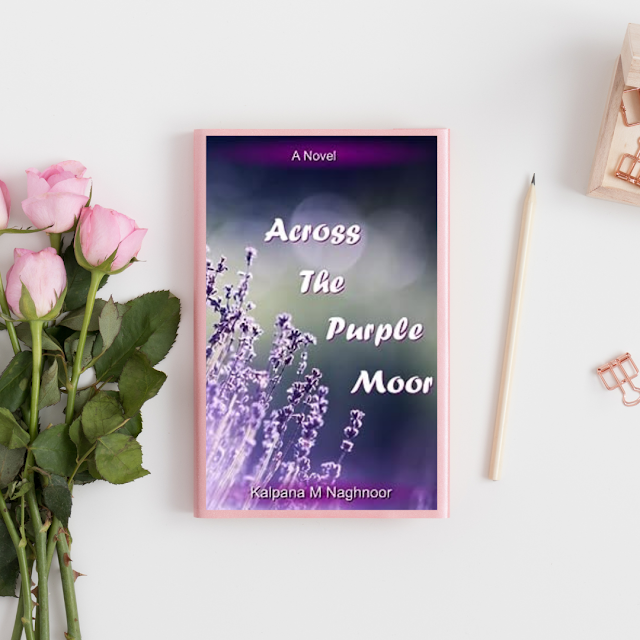Hi, it’s me Mili,
Finally, its May, last month we were busy with A2Z Blog Challenge due to which we were a bit tied up. But here we are again. And this month the first post is mine. Today I am here with the interview of Author Kalpana Naghnoor of the book Across The Purple Moor.
In the world of writing, Kalpana is a big deal. She writes about lots of things like politics and how society works. Her articles appear in big newspapers like The Deccan Herald and The New Indian Express. She also writes about everyday life and food for magazines like Woman’s Era.
Kalpana started writing stories back in 2000 and won a contest in Femina magazine. Since then, she’s written a bunch of stories. Her first book, “Beneath a Sea of Emotions,” was published in Mumbai. People liked her writing style, and she got featured in The Hindu newspaper. She even got a story published by Unisun, a group supported by the British Council, India.
She’s written more books, like “Recollections from a Crawlway” and some novels, including “Abstruse,” “Die if You Must,” and “When Hope is All You Have.” She also wrote a book called “Say Namaste” about Hindu religion. Aakar Publications published some of her books.
Aside from writing, she also helps out with writing and editing for online media. Kalpana’s writing is popular because it talks about life in India today in a way that people of all ages can understand and enjoy.

Mili: What inspired you to write “Across The Purple Moor”? Was there a specific event or idea that sparked the creation of Rushali’s story?
Author: Rushali is a voice within me. Ambiguity in urban existence is a complicated issue that triggered me to write the story. Contentious familial expectations and the emerging self often led to irreparable misunderstandings. Across the Purple Moor is a story portraying those battles of urban childhood and a woman’s struggle to claim her own.
Mili: The title of your book, “Across The Purple Moor,” is intriguing. What significance does the purple moor hold in Rushali’s journey, and what inspired the choice of this imagery?
Author: When we think of a moor, we envisage green pastures, which are calm and soothing. Likewise, when we picture childhood, we visualise it in a safe environment filled with assurances and security. But the truth is that some moors are purple. Purple moors have beds that are acidic, yet they exist. In the same way, childhood can be rife with challenges. Some individuals never get over the trauma and become weighed down, yet some grow up to be productive and caring people. One such character is Rushali. She is a remarkable person.
Mili: Rushali’s relationship with her father seems to be a central theme in the book. Can you tell us more about the dynamics between Rushali and her father and how his sudden passing shapes her character development?
Author: Rushali’s father, Dev Pillay, understands why his daughter feels the way she does. However, circumstances are such that he cannot change them for her. Therefore, Dev Pillay encourages Rushali to channel emotions through her artistic talent and pursue her goals. His reposed faith in her abilities spurs her to take on certain responsibilities after his death.
Mili: The protagonist, Rushali, is described as a nonconformist. What challenges did you face in portraying her journey of self-discovery and nonconformity authentically?
Author: The word nonconformist conjures a disruptive personality, but Rushali’s nonconformist is only to shape her life from circumstances that are not conducive. It is a task to portray a character in emotional turmoil and yet evolve into an ideal mother and person. The evolution from a defiant child to an encompassing woman needed to be brought forth by conveying descriptions and situational portrayals.
Mili: How did you create Rushali’s husband? It’s a very complicated character.
Author: A strong-willed woman like Rushali is faced with a stronger adversary, which is her husband. A man ununderstandably morphs from a lover in hard pursuit of her during courtship to someone who holds nothing but disdain for her in their marriage. Creating this character wasn’t easy, especially since, as you mentioned, he is complicated. It’s hard for Rushali to accept the drastic shifts in his personality, and this is the man for whom she nearly forsook the only surviving relationship—the one with her mother.
Mili: The theme of freedom is prominent in the synopsis. Could you elaborate on the concept of freedom explored in the book, and how Rushali’s perception of freedom evolves throughout the narrative?
Author: Rushali is intrinsically a conformist in the way she treasures things, the colour pink, which she likes, as most girls do, and has a helpful nature. However, because she is vocal about her views and chooses liberal arts, it seems like a deviation to her mother, Maya. All Rushali seeks from her mother is acceptance of her person. But Maya likes perfection and does not see that in Rushali. Rushali seeks freedom from being constantly judged. But as fate would have it, her husband is critical of her, also.
Mili: The book seems to touch upon themes of societal judgment and the struggle for acceptance. How did you approach portraying these themes, and what message do you hope readers will take away from Rushali’s experiences?
Author: Yes, Rushali finds societal judgement steeped upon her, first by her mother, Maya, whom others see as the epitome of perfection. Rushali admires her mother but does not aspire to be like her, which her mother reads as defiance. Therefore, her frustrations mount and her defiance amplifies. The takeaway is that urban women, too, have deep emotional struggles. A seemingly privileged life does not insulate trauma. We need to empathise with such struggling individuals.
Mili: This book has a lot characters and a lot of layers, how did you make balance with all these layers?
Author: Life is made up of layers of myriad relationships. The struggle begins early for individuals when their primary relationships are in turmoil. As life progresses, it becomes difficult when the people who are close become judgmental and chisel away your confidence. When confidence breaks, life becomes a struggle. I felt it is important to bring out these situational dilemmas and individualistic struggles in an urban setting. The perception that urbanites have fewer struggles is a myth.
Mili: The synopsis hints at a twist of fate that leads Rushali to paint the moor purple. Can you provide insights into how fate intertwines with Rushali’s creative expression, and do you believe in the power of fate in shaping our lives?
Author: Perception is the finer point of all thoughts. Rushali is a defiant child at first and grows into a person steering through a life of imposed conformity. Suppressing her spirited nature to subjected docility. A life so removed from a person’s true nature is a struggle. So, her subconscious mind wants a life of free expression, but she lives among extremely opinionated people, and their voices are stronger and louder than hers. How did she come to paint the moor purple? It was under certain circumstances. Fate is determined by our actions, which are based on perception. I always believe providence can sneak up on us through our actions.
Mili: As an author, what personal experiences or beliefs did you draw upon while crafting Rushali’s journey, and how does your perspective influence the themes explored in the book?
Author: My books reflect what I feel and see. I build on my experiences and those of others as I see them. Rushali is a voice within me—a voice that begs to be free. I feel that through my narration, people need to see the emotional struggles of urban women. Heartache and misery are not only woven around distant mountains and little hamlets; they exist in the most envied life of an urbanite.


